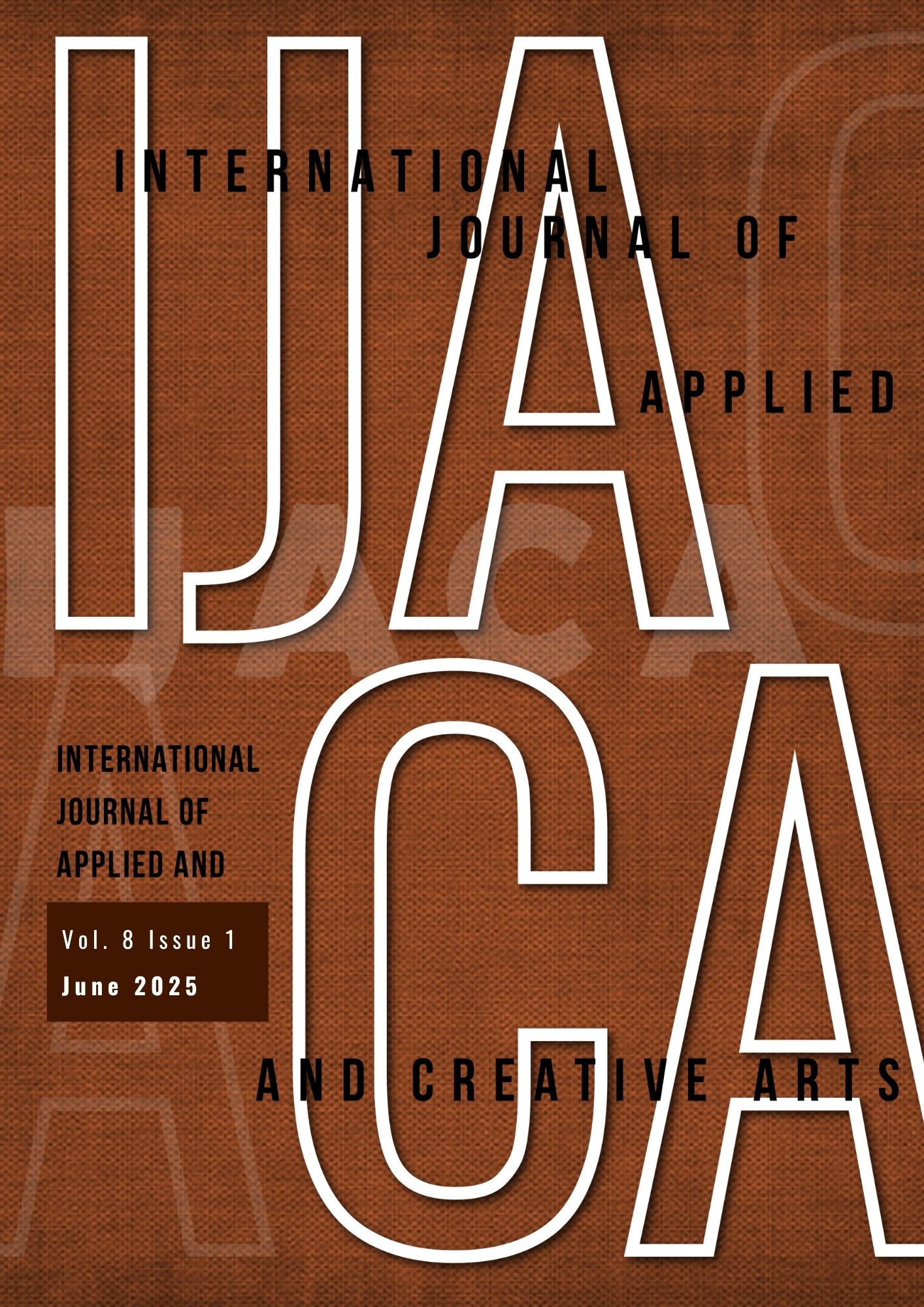Traditional Ethnic Music: Diverse Presentations And Continuity Of Heritage Through The Lens Of “Nüshu Music”
DOI:
https://doi.org/10.33736/ijaca.8769.2025Keywords:
Traditional Ethnic Music, Traditional Culture Heritage, Nushu music, Music EducationAbstract
"Nüshu," the world's only existing script exclusively used by women, is inherited, and utilized among females in the Jiangyong region of Hunan Province. It represents a unique female cultural heritage, notable not only for its distinctive script but also for its expressive nature. Although a written language, "Nüshu" is also conveyed through singing, making it a syllabic script where each character represents a single syllable. Comprehension of its content necessitates performance through singing. Due to its unique reading method of "singing," "Nüshu" is inextricably linked to music, rendering it of significant value for musicological research. This paper delves into the modern representation of "Nüshu" music, employing methods of data collection and literature analysis to explore how traditional ethnic music, under the illumination of technological advancements, can be integrated with technological means to offer diversified and enriched forms of presentation. The primary research objective is to convey the beauty of traditional ethnic music to the public in a more intuitive manner and to facilitate its teaching and transmission through innovative approaches. It hopes to provide support for the transmission and education of traditional folk music.
References
Chen,X.,& Xiong, Y.(2019). Research on the Inheritance and Development of Nüshu in Jiangyong under the New Media Background. Jouenalism Research Guide, 11 , 15-16.
Dong, Q., Zhou, Y.P., & Tao,Y. (2023). A Preliminary Exploration of Nüshu Music in Yongzhou. House of Drama, 01, 101-103.
Liu, D (2017). Dialogue between the Past and the Future: An Analysis of Tan Dun's Microfilm Symphony "Nüshu" (Master's thesis, Southwest University).
Li,F.,& Su, C. (2015). The Impact of Emerging Media on the Cross-cultural Transmission of Chinese Ethnic Music. Music Communication, No.24.01, 85-8
Liu,T.Y.(2022). Exploring the Cultural Elements of Ethnicity in Chinese Pop Music. Cultural Industries, 13, 40-42
Tan, Y. (2017). Research on Nüshu Music in Jiangyong from the Perspective of Ethnic Musicology (Master's thesis, Jiangxi University of Science and Technology Normal)
Wang, G. (2019). "Narrative Discourse" in Narrative Dance Themes: A Case Study of the Dance Work "Nüshu·Yin." Art and Sea, 12, 53-55.
Yang, L. (2019). Analysis of Humanistic Characteristics in Tan Dun's Microfilm Symphony "Nüshu." Voice of the Yellow River, 11, 136-137. doi:10.19340/j.cnki.hhzs.2019.11.107.
Yaang,J. (2021). Multiple Structures of Auditory Music and Visual Images in Cognitive Context: Some Thoughts Triggered by the Analysis of Tan Dun's Multimedia Music Works “Map” and "Nüshu." New Sounds of Music, 02, 18-26.
Zhang, Y. (2006). A Study of Nüshu Music in Jiangyong, Hunan (Master’s thesis, Wuhan Consevatory of Music)
Downloads
Published
How to Cite
Issue
Section
License
Copyright (c) 2025 UNIMAS Publisher

This work is licensed under a Creative Commons Attribution-NonCommercial-ShareAlike 4.0 International License.
Copyright Transfer Statement for Journal
1) In signing this statement, the author(s) grant UNIMAS Publisher an exclusive license to publish their original research papers. The author(s) also grant UNIMAS Publisher permission to reproduce, recreate, translate, extract or summarize, and to distribute and display in any forms, formats, and media. The author(s) can reuse their papers in their future printed work without first requiring permission from UNIMAS Publisher, provided that the author(s) acknowledge and reference publication in the Journal.
2) For open access articles, the author(s) agree that their articles published under UNIMAS Publisher are distributed under the terms of the CC-BY-NC-SA (Creative Commons Attribution-Non Commercial-Share Alike 4.0 International License) which permits unrestricted use, distribution, and reproduction in any medium, for non-commercial purposes, provided the original work of the author(s) is properly cited.
3) For subscription articles, the author(s) agree that UNIMAS Publisher holds copyright, or an exclusive license to publish. Readers or users may view, download, print, and copy the content, for academic purposes, subject to the following conditions of use: (a) any reuse of materials is subject to permission from UNIMAS Publisher; (b) archived materials may only be used for academic research; (c) archived materials may not be used for commercial purposes, which include but not limited to monetary compensation by means of sale, resale, license, transfer of copyright, loan, etc.; and (d) archived materials may not be re-published in any part, either in print or online.
4) The author(s) is/are responsible to ensure his or her or their submitted work is original and does not infringe any existing copyright, trademark, patent, statutory right, or propriety right of others. Corresponding author(s) has (have) obtained permission from all co-authors prior to submission to the journal. Upon submission of the manuscript, the author(s) agree that no similar work has been or will be submitted or published elsewhere in any language. If submitted manuscript includes materials from others, the authors have obtained the permission from the copyright owners.
5) In signing this statement, the author(s) declare(s) that the researches in which they have conducted are in compliance with the current laws of the respective country and UNIMAS Journal Publication Ethics Policy. Any experimentation or research involving human or the use of animal samples must obtain approval from Human or Animal Ethics Committee in their respective institutions. The author(s) agree and understand that UNIMAS Publisher is not responsible for any compensational claims or failure caused by the author(s) in fulfilling the above-mentioned requirements. The author(s) must accept the responsibility for releasing their materials upon request by Chief Editor or UNIMAS Publisher.
6) The author(s) should have participated sufficiently in the work and ensured the appropriateness of the content of the article. The author(s) should also agree that he or she has no commercial attachments (e.g. patent or license arrangement, equity interest, consultancies, etc.) that might pose any conflict of interest with the submitted manuscript. The author(s) also agree to make any relevant materials and data available upon request by the editor or UNIMAS Publisher.

